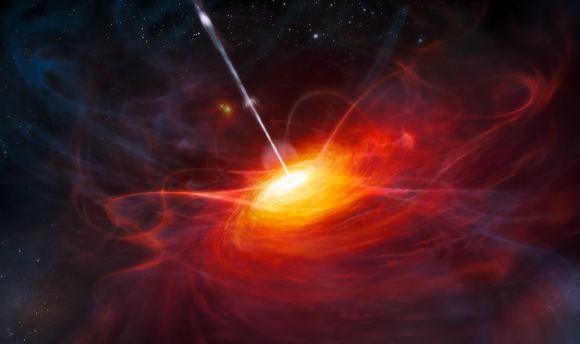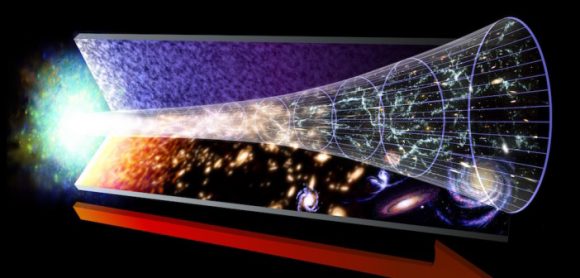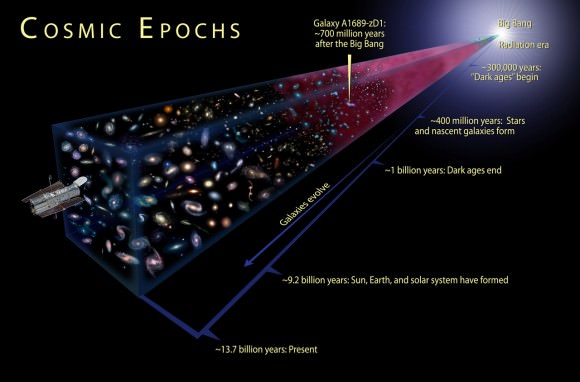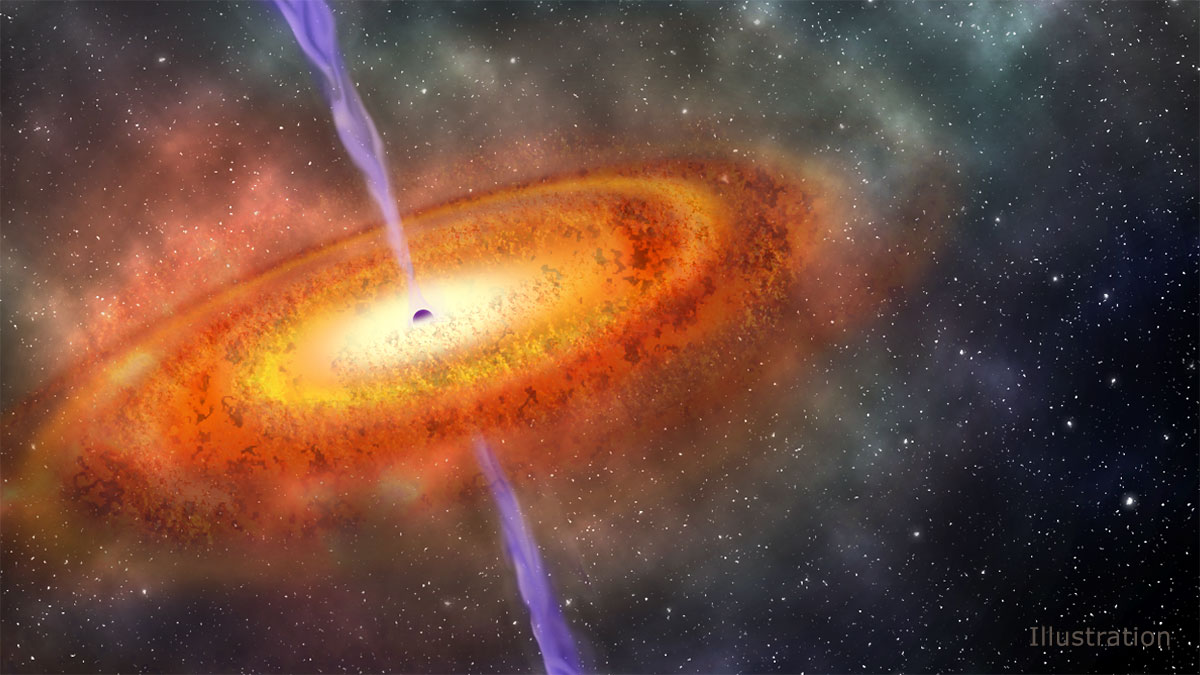It is a well known fact among astronomers and cosmologists that the farther into the Universe you look, the further back in time you are seeing. And the closer astronomers are able to see to the Big Bang, which took place 13.8 billion years ago, the more interesting the discoveries tend to become. It is these finds that teach us the most about the earliest periods of the Universe and its subsequent evolution.
For instance, scientists using the Wide-field Infrared Survey Explorer (WISE) and the Magellan Telescopes recently observed the earliest Supermassive Black Hole (SMBH) to date. According to the discovery team’s study, this black hole is roughly 800 million times the mass of our Sun and is located more than 13 billion light years from Earth. This makes it the most distant, and youngest, SMBH observed to date.
The study, titled “An 800-million-solar-mass black hole in a significantly neutral Universe at a redshift of 7.5“, recently appeared in the journal Nature. Led by Eduardo Bañados, a researcher from the Carnegie Institution for Science, the team included members from NASA’s Jet Propulsion Laboratory, the Max Planck Institute for Astronomy, the Kavli Institute for Astronomy and Astrophysics, the Las Cumbres Observatory, and multiple universities.

As with other SMBHs, this particular discovery (designated J1342+0928) is a quasar, a class of super bright objects that consist of a black hole accreting matter at the center of a massive galaxy. The object was discovered during the course of a survey for distant objects, which combined infrared data from the WISE mission with ground-based surveys. The team then followed up with data from the Carnegie Observatory’s Magellan telescopes in Chile.
As with all distant cosmological objects, J1342+0928’s distance was determined by measuring its redshift. By measuring how much the wavelength of an object’s light is stretched by the expansion of the Universe before it reaches Earth, astronomers are able to determine how far it had to travel to get here. In this case, the quasar had a redshift of 7.54, which means that it took more than 13 billion years for its light to reach us.
As Xiaohui Fan of the University of Arizona’s Steward Observatory (and a co-author on the study) explained in a Carnegie press release:
“This great distance makes such objects extremely faint when viewed from Earth. Early quasars are also very rare on the sky. Only one quasar was known to exist at a redshift greater than seven before now, despite extensive searching.”
Given its age and mass, the discovery of this quasar was quite the surprise for the study team. As Daniel Stern, an astrophysicist at NASA’s Jet Propulsion Laboratory and a co-author on the study, indicated in a NASA press release, “This black hole grew far larger than we expected in only 690 million years after the Big Bang, which challenges our theories about how black holes form.”

Essentially, this quasar existed at a time when the Universe was just beginning to emerge from what cosmologists call the “Dark Ages”. During this period, which began roughly 380,000 years to 150 million years after the Big Bang, most of the photons in the Universe were interacting with electrons and protons. As a result, the radiation of this period is undetectable by our current instruments – hence the name.
The Universe remained in this state, without any luminous sources, until gravity condensed matter into the first stars and galaxies. This period is known as the “Reinozation Epoch”, which lasted from 150 million to 1 billion years after the Big Bang and was characterized by the first stars, galaxies and quasars forming. It is so-named because the energy released by these ancient galaxies caused the neutral hydrogen of the Universe to get excited and ionize.
Once the Universe became reionzed, photons could travel freely throughout space and the Universe officially became transparent to light. This is what makes the discovery of this quasar so interesting. As the team observed, much of the hydrogen surrounding it is neutral, which means it is not only the most distant quasar ever observed, but also the only example of a quasar that existed before the Universe became reionized.
In other words, J1342+0928 existed during a major transition period for the Universe, which happens to be one of the current frontiers of astrophysics. As if this wasn’t enough, the team was also confounded by the object’s mass. For a black hole to have become so massive during this early period of the Universe, there would have to be special conditions to allow for such rapid growth.

What these conditions are, however, remains a mystery. Whatever the case may be, this newly-found SMBH appears to be consuming matter at the center of a galaxy at an astounding rate. And while its discovery has raised many questions, it is anticipated that the deployment of future telescopes will reveal more about this quasar and its cosmological period. As Stern said:
“With several next-generation, even-more-sensitive facilities currently being built, we can expect many exciting discoveries in the very early universe in the coming years.”
These next-generation missions include the European Space Agency’s Euclid mission and NASA’s Wide-field Infrared Survey Telescope (WFIRST). Whereas Euclid will study objects located 10 billion years in the past in order to measure how dark energy influenced cosmic evolution, WFIRST will perform wide-field near-infrared surveys to measure the light coming from a billion galaxies.
Both missions are expected to reveal more objects like J1342+0928. At present, scientists predict that there are only 20 to 100 quasars as bright and as distant as J1342+0928 in the sky. As such, they were most pleased with this discovery, which is expected to provide us with fundamental information about the Universe when it was only 5% of its current age.
Further Reading: NASA, Carnegie Science, Nature


For what I have read this aticle should refer to the recent discovery of ULAS J1342+0928, the discovery of which was published a few days ago on december 6th, 2017 and not to ULAS J1120+0641 which was discvoered in june 2011 and is now the second most distant known quasar.
I would suggest that you confirm that and make the correction acordingly. Those reference numbers are in any case horrible and it is pretty easy to confuse them.
Yes, sir, you are correct. Good eye too. That quasar is mentioned in the study and I guess I fudged the numbers once and just kept repeating it 🙂
The article says this discovery has raised many questions … indeed.
I wish the world were a little different, lol I wish you could openly question a few things and maybe rightfully so you cannot without being called a nut job or that you are merely sowing discord or even hit with concerns of being labeled fanatical/magically inclined. Perhaps this mentality was born out through what could be known as the Galilean struggle with the church in determing where Earth lies in our solar system. Earth was found to be circling the Sun and not vice versa and all of the whackness that occurred to globally accept that was like, well it took a long time and a lot of pain.
I guess what Iam getting at is maybe there are some things we don’t know. Maybe the Universe is far older, maybe the black hole did not grow at an astounding rate, maybe it has been around a lot longer. Questioning the age of the Universe nowadays feels … like a bad thing to do considering all the freaky and self serving agendas out there. The last thing I would be trying to do is muster doubt and confusion, for there is evidence as to why we have our Big Bang Theory.
I have a question though. Time is relative, I know we can prove that the faster you go the slower time ticks by like with GPS and stuff, the movie Interstellar showed this during the near encounter with the black hole. Things in orbit experience time dilation for instance relative to us on the surface, small but measurable. So what I am getting at is what if both things are true, that the age of the Universe is 13.8 billion years old but it HAS been around much longer. Perhaps with that rapid expansion of space time itself slowed to where 1 second was a million years or something. We would see it as 13.8 billion but relatively speaking it might be much much older. Time, space and velocity all effect one another. If moving at the speed of light slows time inexorably, and the expansion of space can move greater than the speed of light … how does that effect what we perceive as time. Is it possible to be 13.8 billion years old, and still be much much older. Lol.
Our relative observations are just that: relative. If our observations made within reference frame is set at 13.8 billion years, that’s the number it is. If we were in a different reference frame, our observed numbers would be, as well, different, accomodating that reference frame.
All said, the top minds in these fields –the ones doing the research– have most definitely taken into account anything people that aren’t trained in this at all, or even less than they are, into account.
An “outsider” rarely, rarely, RARELY thinks up something that these folks haven’t already well explored.
I was under the impression that the age of the universe was somewhat up for argument within the scientific community.
There really is not any reason to just stop asking questions simply because one is not an expert. Imagination will always dwarf knowledge. Yes, I am sure they have thought about it before, as do I, I think about these types of questions every single day for hours and hours sitting talking driving it don’t matter, my dreams consist of amazingness from time to time. I cannot shut it off, and really can’t describe it, I feel compelled to ask questions simply for the sake of asking the question. I feel pulled to keep an open mind and to realize that we have really only tapped the surface of what is probably what could be an infinite intelligence. To know all.
I am not presenting a thesis here, Iam just wondering out loud.
Also, there is a way to influence a great mind from a lesser mind, some call it a spark or possibly a muse. You know in all those movies when the dumb guy says “well why don’t we ab and c”, and the smart guy goes “your a genius”. Not because they were going to do abc but because abc gave them an insight into something that might work.
I am sure nobody will read this and go “oh, let me check a few things just … in … case” and then find the answer to the universe, but I can hope sir, I can certainly hope in some small way maybe some day I might stumble across someone stumbling and spark an idea in their mind that leads somewhere, perhaps they didn’t even know they were stumbling. For what other purpose of a comment is there?
Cheers
Oh, and by the way, there is a black hole out there that is larger than it could even be. Wondering aloud my friend, wondering aloud.
The reason we are so steadfast and sticking to the 13.8, is certainly because of the Galalean issues that I referred to earlier. Horrible things can arise from ignorance, must not fall down the same path of those we know to be ignorant.
Sorry, I am a bit too dramatic, and too much of a dreamer with not enough plugging away in the numbers. For those plugging away in the numbers though, they might not be enough of a dreamer. There are a special few among us who encompass the best of both worlds at the right times in the right amounts I am sure. Which is why I try to withhold 99% of my thoughts, dont want to muddy the waters when I cant even explain why the water is wet or what the mud is made of.
When was the age of 13.8 billion years determined?
If I recall, it seems as if many years ago it was 14 billion and some thing.
So if the the JWST see objects pass this point, or a empty black space, what a wonderful world of science it will be.
The age of the universe will quite possibly continuously be revised as new observations are made and new theories proposed. For the time in which we exist, the evidence points most professional scientists toward about 14 gigs. It could be completely wrong, so keep on questioning and using your imagination. That’s what makes this stuff so fun.
A black hole consists of Dark Matter http://vixra.org/pdf/1303.0207v3.pdf
I am assuming the age/distance is being calculated from the hubble constant with some correction for gravitational redshift. Given the apparent tremendous mass, a revisit to the gravitational redshift is in order. My feeling is that the gravitational redshift has been underappreciated and this object is both closer and older than initially calculated.
Maybe this too large black hole is actually a leftover from before the big bounce?
https://www.space.com/38982-no-big-bang-bouncing-cosmology-theory.html
I do not understand why this is such a surprise. The Universe was MUCH smaller back then, with pretty much all of the energy (and basically all of the baryonic and dark matter) that it has today. Everything was much closer together, so it would stand to reason that there would be many very large stars forming, going supernova, ending in a black hole, and the shockwaves would stimulate more large star formation in neighboring clouds of gas. It would seem to me that supernovas in the early universe would be going off much more often than today (akin to popcorn in your microwave), with the rate decreasing as the universe expands/cools and gas and dust become more spread out. That would mean plenty of black holes, and black hole mergers, thus dramatically increasing the odds of supermassive black holes forming compared to the odds of new ones forming today.
Is there anyone (not a crackpot) that can explain why the scientific community is so surprised at this find?